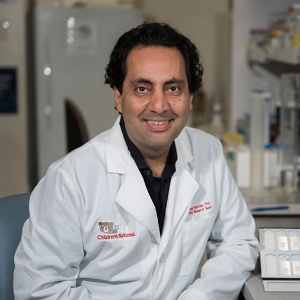Grants
The DIPG / DMG Collaborative has funded $19,223,550 in DIPG/DMG research.
Interested in applying for a grant from the DIPG / DMG Collaborative? Learn more.

Yale University - $100,000
$100,000.00
November 2013
Pre-Clinical Development of Novel DIPG Radiosensitizers
Hypothesis: Diffuse intrinsic pontine glioma (DIPG) is a devastating disease with an almost universally fatal prognosis. Despite many clinical trials testing numerous chemotherapies and targeted systemic agents, both concurrent with RT and in the adjuvant setting, these therapies have not changed OS. We and others believe that 3 major issues contribute to the poor response to therapy in DIPG patients treated with RT and concurrent systemic therapies. First, drug penetration into DIPG tumors is severely limited by the blood brain barrier. Second, many systemic therapies have been tested in DIPG based on extrapolation from adult high grade glioma trials, without a clear rationale for testing in this genetically distinct tumor type. Finally, the evidence underlying the radiosensitizing potential of many of these agents is lacking. We hypothesize that nanoparticlemediated and convection-enhanced (CED) drug delivery, coupled with the use of targeted radiosensitizers which have been validated in DIPG cells, will lead to higher rates of local control and consequent OS for this disease. As described below, we will test this hypothesis in a proposed one year pilot study focused on the pre-clinical development of novel DIPG radiosensitizers. Background: As noted above, DIPG is a devastating tumor, with most patients succumbing to their disease within 2 years after diagnosis. Focal RT is the only treatment which has shown a benefit in DIPG, although it extends OS by only ~3-4 months. Remarkably, numerous chemotherapy combinations, RT fractionation regimens, and novel systemic agents have been tested in DIPG, without any appreciable OS improvements in the last 30 years. In addition, many agents were tested in DIPG based on observed activity in adult GBM, and temozolomide (TMZ) is one example. Unfortunately, studies now confirm that TMZ is not effective in DIPG when added to standard RT. Given that virtually all DIPGs recur locally, there has been great interest in testing novel combinations of targeted systemic therapies with RT, as a means to enhance local control via radiosensitization. Examples include small molecules targeting Aurora Kinase B, VEGFR-2 and PDGFR. DSB repair pathways play critical roles in the response to IR, as highlighted by the exquisite radiosensitivity of cells from patients with inherited DSB repair defects. It is now known that key DNA damage and checkpoint genes are up-regulated in DIPG, including the Chk2 and WEE1 kinases, suggesting a role for DSB repair inhibition as a radiosensitization strategy. While these are promising strategies, recent studies suggest that the efficacy of DIPG therapies is severely limited by drug delivery, which suggests novel methods are needed to ensure adequate tumor targeting. Goals, Design and Methods: We have recently performed a high-throughput screen for novel DNA double-strand break (DSB) repair inhibitors, which led to the identification of several lead compounds with radiosensitizing activity in vitro. We propose to test these compounds as potential radiosensitizers in primary DIPG cells in vitro, and several of the most promising lead hits will then be encapsulated in nanoparticles to facilitate drug delivery into DIPGs in vivo. Finally, three molecules will be selected for testing as radiosensitizers in a DIPG xenograft mouse model in vivo. Clinical Significance: Our proposed studies have the potential to identify novel therapeutics which can be tested in DIPG patients, and they represent an important proof-of-principle, which can be used as the basis to test other drugs as novel DIPG radiosensitizers in the future. Research Team: This application brings together two new Principal Investigators (PI’s) from Yale Medical School, Bindra and Zhou, with complementary research expertise in DSB repair and nanoparticle drug delivery, respectively. Importantly, they share a common goal of developing novel therapeutics for the treatment of adult and pediatric high grade gliomas. Bindra is a physicianscientist in the Department of Therapeutic Radiology, with a clinical and research focus on pediatric CNS tumors, including DIPGs. His laboratory is developing cell-based screening approaches to identify novel radiosensitizers for high grade gliomas. He is particularly interested in eventually translating these discoveries into the clinical setting, via the development of investigator-initiated Phase I trials. Zhou is a translational scientist in the Department of Neurosurgery, with substantial experience in nanoparticle research and CNS drug delivery. His laboratory is focused on developing novel, nanoparticle-based drug delivery systems.

Monash Institute of Medical Research - $99,620
$99,620.00
November 2013
Targeted Therapy and Stem Cell Therapy for DIPG
BACKGROUND: Diffuse intrinsic pontine glioma (DIPG) is the leading cause of brain cancer associated deaths in children despite constituting only 10-15% of childhood brain tumours. Approximately 300 children per year with a median age of 6-7 years will be diagnosed with DIPG in the US [about 20 per year in Australia]. Currently, radiotherapy is the only treatment offered as no effective chemotherapeutic is available and surgery is not an option due to tumor location. As a result, the median survival time is less than 12 months. This statistic unfortunately has not changed in over 35 years of investigation and highlights an urgent need for new and novel methods of targeting DIPG. SCIENTIFIC MERIT AND FEASIBILBITY: Our research program identifies targeted therapeutics, both small molecule inhibitors and monoclonal antibodies, directed to cell-surface receptor tyrosine kinases (RTKs) that have potential efficacy in brain cancer. We are now beginning to apply this expertise to DIPG. DIPG is a highly heterogeneous tumor with a variety RTKs responsible for tumor initiation (PDGFRα), growth (EGFR), vascularisation (VEGFRs), dissemination (c-Met) and stem/progenitor cell maintenance (c-Kit). Although a number of clinical trials are under way using small molecule inhibitors and humanised monoclonal antibodies targeting EGFR with nimotuzumab [1], VEGFR and EGFR with Vandetanib [2] and PDGFR with Dasatinib [3], most have had limited success and appear to target one or two oncogenic proteins. In the first part of our proposal we will use a multi-targeting agent (AMG706 targeting PDGFRs, VEGFRs, c-Kit) and the single targeting agents AMG102 (targeting HGF, the c-Met ligand) and panitumumab, which targets wild type EGFR (EGFRwt) and the truncation mutant EGFRvIII), alone and in combination, to inhibit multiple cellular subpopulations and multiple growth promoting RTKs expressed in DIPG. In addition, we will investigate the novel anti-tumor activity of human amniotic stem cells (hASC) in DIPG, as these cells have demonstrated antiRTK activity and apoptosis inducing activity in glioblastoma multiforme (GBM) in vitro and in vivo. Our extensive expertise in brain cancer research and access to novel therapeutic agents makes this proposal scientifically significant and highly feasible. HYPOTHESES: 1: Targeting multiple activated RTKs in DIPG will be an effective therapeutic strategy; 2: hASC will have anti proliferative and anti-tumorigenic effects against DIPG sphere lines; 3: The combination of both these strategies will have enhanced anti-tumor activity in DIPG. SPECIFIC AIMS We will determine: 1: the anti-tumor activity of AMG706 in combinations with AMG102 and panitumumab against a panel of patient derived DIPG sphere cell lines in vitro and in vivo by conducting tumorigenicity-related functional assays (e.g. proliferation, cell cycle, apoptosis assays), and assessing RTK expression and activation, and orthotopic xenograft growth; 2: the anti-tumor activity and mechanisms of action of hASC against DIPG sphere cell lines in vitro and in vivo as described in Aim 1; 3: the anti-tumor activity of the therapeutic strategies in Aims 1 and 2 in in vivo subcutaneous and orthotopic xenograft models of DIPG. PROJECT GOALS: To identify novel anti-tumor therapeutic strategies for DIPG DESIGN AND METHODS: Our study will utilize primary DIPG sphere cell lines isolated from autopsied material to evaluate new therapies both in vitro and in orthotopic xenograft models of DIPG. CLINICAL SIGNIFICANCE: This study will evaluate several targeted therapeutics (some that are in clinical trials and one that is approved by the Food and Drug Administration) that recent discoveries suggest should have anti-tumor activity in DIPG. As these therapeutics are already in the clinic, and because we will evaluate them in clinically relevant DIPG xenograft models, there will be the opportunity to rapidly translate them into the clinic. In this proposal, the therapeutic value of hASC in DIPG will also be assessed. These cells are already being used clinically in our institute; therefore, if our data indicate that they have therapeutic potential, we have the ability to conduct a trial in patients with DIPG. In the long term, we hope to design new therapeutic strategies that extend the lives of patients with DIPG.

Ann and Robert H. Lurie Children's Hospital of Chicago - $100,000
$100,000.00
November 2013
Ex-vivo expanded natural killer (NK) cells to target DIPG tumor cells in pre-clinical studies
Diffuse Intrinsic Pontine Glioma (DIPG) is a rare high-grade glial tumor that occurs in young children and is nearly uniformly fatal. Several factors have contributed to the high fatality in children with DIPG. It occurs in, a region, making surgery potential dangerous. Complete surgical resection of tumor is impossible because of the highly invasive nature and ill-defined boundaries of the tumor. Radiation has been used in DIPG treatment, but it is not curative and merely extends life by a very short time. Delivery of chemotherapeutic agents to the tumor has been hindered by the existence of the blood brain barrier. Doses of drugs that result in significant systemic toxicity have to be administered to obtain minuscule reduction in tumor growth. Thus, there is a dire need for novel therapeutic approaches to improve survival in children with DIPG.
In the current application, we propose to evaluate the feasibility of using ex-vivo expanded natural killer (NK) cells to target DIPG tumor cells in pre-clinical studies. NK cells are a subset of lymphocytes characterized by CD56 positivity and CD3 negativity (CD56+, CD3-). Their use for cancer therapy is particularly appealing because these immune cells unlike T- and B-cells can lyse tumors without prior immune sensitization. NK cell-mediated cytotoxicity is highly dependent on their ability to distinguish "self' (normal cells) from non-self (tumor cells). Our vitro data show that (a) DIPG cells are sensitive to NK-mediated cytolysis and (b) histone deacetylase inhibitors (HDACis) upregulate genes such as NKP30 and NKG2D, which are critical for NK-tumor recognition of tumor cells. Here. we will build upon these findings to assess if loco regional administration of NK cells [using a guide screw or convection enhanced delivery (CED)] in mouse orthotopic models of DIPG will promote tumor shrinkage. We will also ask if HDACI-mediated increase in tumor cell recognition by NK cells will augment DIPG cell cytolysis.
The specific aims of our study are:
Aim I. To study the cytolytic activity of NK cells delivered loco-regionally in mouse orthotopic models of DIPG. We will first evaluate the cytolytic activity of ex vivo expanded NK cells from five other anonymous donors using fluorescence-based cytolysis assays. NK-sensitive, firefly luciferase marked DIPG cells will be implanted in the brain stem of mice and treated with graded doses of NK cells labeled with a fluorescent lipophilic dye (DIR) and delivered by a guide screw or convection enhanced delivery (CED). Tumor response will be measured by bioluminescence imaging. NK persistence will be assessed by fluorescence imaging.
Aim II. NK cells will be combined with an HDACI, MS-275, which we previously showed to upregulate tumor recognition molecules on NK cells to evaluate its effect on NK cell cytolytic activity in vitro. In vivo, we will combine the two agents at doses where each alone promotes 20% killing. The involvement of tumor recognition molecules in augmentation of NK function will be shown by using specific blocking antibodies.
Feasibility and Innovation: Feasibility is shown by: (a) the proven expertise of our multi-institutional and multi-disciplinary team in basic and translational neuro-oncology (b) availability of platform technologies that we have developed, using artificial antigen presenting cells (aAPC) to expand clinical-grade NK cells (b) our unique brainstem DIPG mouse model and cell lines generated from autopsy material and finally (c) our expertise in delivering chemotherapy to the brain stem using guide screw and CED.
Clinical Relevance and Significance: The proposed project is based on our unique access to and ability to use clinically-adaptable agents: (i) aAPC, (ii) NK cells and (iii) narrow-spectrum HDACi, Our group has ongoing clinical trials infusing NK cells to treat children with non-neural tumors. Based on our recent pre-clinical research on medulloblastoma (MB) and atypical teratoid rhabdoid tumor (ATRT) (section III-C and data not shown), we are in the process of seeking regulatory approval to open the first in pediatrics immunotherapy trial for children with fourth ventricular tumors through loco-regional administration of ex vivo expanded NK cells. The successful completion of this study will (a) provide pre-clinical evidence for the therapeutic application of NK cells in children with DIPG and (b) provide a rationale for novel synergistic combinations of NK cells and other therapeutic agents. The proposed work has the potential to create a paradigm shift in DIPG treatment.

The Hospital of Sick Children - $100,000
$100,000.00
November 2013
Investigating Mechanisms of Therapeutic Resistance in DIPG.
Brain tumors are the largest group of solid tumors and the leading cause of cancer-related deaths in childhood1. The most devastating of these is DIPG, an incurable tumor with a median survival of less than one year2,3. DIPGs show poor response to conventional therapy and until recently we have lacked knowledge of the molecular profile of DIPG hindering development of targeted therapeutics. Toward a better understanding of the molecular profile of DIPG, our group at the Hospital for Sick Children was the first to institute a post-mortem tissue collection protocol for DIPG patients and to use this material to obtain high resolution molecular genetic profiles of these tumors. Through highresolution DNA and RNA microarray analysis of these tumors we uncovered potential therapeutic targets, including PDGFRA, PARP and aurora kinase B4,5, for which therapeutic agents are already available. We have since expanded our protocol to include centers from across Canada and the U.S. and now have one of the largest DIPG tissue banks, with matching clinical data in the world. Discovery of recurrent histone mutations in pediatric GBM has revolutionized our thinking about the pathogenesis of DIPG6-8. A highly recurrent mutation was found in variant histone H3.3 at amino acid 27 resulting in lysine to methionine substitution (H3.3K27M). While recent data suggests that the presence of the mutated histone results in global loss of methylation of K27 through inhibition of the histone methyltransferase EZH2, how this causes cancer and whether blocking the effects of this mutation can be used to treat DIPG is still unknown. In Aim 1 we propose an siRNA screening approach to identify drugs targeted specifically to DIPGs carrying the K27M mutation. Our siRNA screen is designed to identify genes that are directly targetable through specific small molecule inhibitors. Despite this huge explosion of genomic data, there has been little movement in identifying which of these mutations, or over-expressed genes in DIPG are bona fide therapeutic targets. Further, we still have little understanding of the reasons for the minimal therapeutic effect of traditional agents, such as radiation and temazolamide, which seem to provide at least some survival benefit for adult patients with high grade astrocytomas. Therefore there is a critical need to understand the basis of this therapeutic resistance in DIPG and translate this into effective treatment protocols for these children. In adult GBMs, the protein MGMT has been shown to be an important mediator of resistance to temozolamide and patients whose tumors express this protein have a worse overall survival. However, we have demonstrated that MGMT is infrequently expressed in DIPG suggesting an alternate mechanism of therapeutic resistance exists. Another major pathway involved in repairing alkylating-agent mediated damage is the base excision repair pathway. Our data shows that this pathway is highly active in pediatric GBM and that inhibiting this pathway can restore response to temozolamide in both in vitro and in vivo models. We hypothesize that resistance to traditional forms of treatment, namely radiation and alkylating agents such as temozolomide are promoted through the base excision repair pathway in DIPG. The potential for blocking the base excision repair pathway to overcome resistance of DIPGs to radiation and alkylation agents will be tested in Aim 2. The protocols developed in Aim 2 can then be used to test targets from Aim1 in the future. Our approach will yield highly promising drug targets that can be readily tested in DIPG models and rapidly transitioned to phase I clinical trials. We have the facilities and expertise at the Brain tumor research at The Hospital for Sick Children in Toronto that will allow us to take these preclinical model approaches and eventually transition into clinical trials with our dedicated team of neuro-oncologists. Our innovative approaches of targeting novel DNA repair proteins in combination with standard therapy and our functional siRNA screen will allow us to identify novel therapeutic strategies to treat children with DIPG.

Dana-Farber Cancer Institute - $50,000
$50,000.00
November 2013
Phase II Trial of Molecularly Determined Treatment of Children and Young Adults with Newly Diagnosed Diffuse Intrinsic Pontine Gliomas.
Scientific Merit: The prognosis of diffuse intrinsic pontine gliomas (DIPGs) has not improved significantly over the last 40 years. A major reason for this limitation is the lack of an understanding of the underlying biology of these tumors, as well as the absence of appropriate targets for therapeutic intervention. The biologic material for DIPGs that is available consists predominantly of autopsy specimens. While the analysis of these samples will provide important clues about the disease, the lack of material at the time of diagnosis continues to hamper significant progress. With dramatic advances in neurosurgical techniques that now permit the safe biopsy within the brainstem, coupled with dramatic advances in molecular profiling of very small quantities of tumor material, we can now move forward towards a direct examination of these tumors prior to the influence of radiation and chemotherapy. In collaboration with the Dana-Farber/Harvard Cancer Center, the Dana-Farber Center for Cancer Genome Discovery and the Broad Institute, as well as the active participation of approximately 20 of the largest pediatric neuro-oncology programs in the country, we are ready to embark on a new direction in the treatment of DIPG.
Disease Impact: Our approach to DIPG over the last 40 years speaks for itself. Not only do the innumerable negative clinical trials speak about our failure to change the course of this disease after all of this time, but also, we are no further ahead in terms of our understanding of these tumors or their treatment. As such, bold steps are needed to change our current approach and this proposal addresses this issue head on.
Innovation: The current clinical trial proposal is innovative in multiple ways. It builds on our improved neurosurgical expertise, thus allowing us to obtain tissue from newly diagnosed patients with the classical clinical and radiographic criteria of DIPG. We will then treat patients based on components of the individual analysis of their tumor for expression of EGFR and MGMT. This will be the first major effort of this kind and will provide important answers to the role of MGMT and EGFR for patients with newly diagnosed DIPG. While any therapy combination can be criticized and replaced by different combinations, the 4 agents selected for this trial meet the following important principles. First, radiation therapy is the standard of care and provides important effects on the tumor. We have also included bevacizumab for all patients based on the expression of VEGF in all malignant gliomas (recall that vascular proliferation is one of the diagnostic criteria of these tumors). While the presence of vascular proliferation is largely based on autopsy cases in DIPG patients, the rational for this approach is justified in newly diagnosed patients as well. The use of temozolomide is only appropriate in the absence of MGMT expression and this protocol will avoid this agent in patients unlikely to benefit, while allowing those that are MGMT negative (even if this is a small subset of patients) the opportunity to receive the drug and evaluate its potential activity. Finally, EGFR has been demonstrated in a number of DIPG autopsy cases, and this protocol will allow us to settle the relevance of this pathway in these tumors. Most importantly, all samples will undergo extensive molecular profiling to identify new pathways and targets for potential intervention in future studies.
Feasibility: The ability of the French group at Institut Gustave Roussy to complete more than 120 consecutive biopsies without mortality or prolonged morbidity demonstrates that biopsy of the pons can be performed. We have now performed 15 biopsies through this effort without significant morbidity and no mortality. We have already demonstrated the validity of all of the molecular techniques proposed in this protocol using samples from pediatric low-grade gliomas.
Expertise: We have been able to bring together approximately 20 major pediatric neurosurgical programs in the United States to obtain samples, which can then undergo molecular profiling through the Dana-Farber/Harvard Cancer Center, Dana-Farber Center for Cancer Genome Discovery and the Broad Institute. We have clinical pediatric oncologists with experience in the administration of the agents being proposed and have included significant oversight to ensure that all patients receive the same high standard of care.

Texas Children's Cancer Center - $100,000
$100,000.00
November 2013
Targeting DIPGs in vivo in Intra-brain Stem Xenograft Mouse Models through Combined Radiation and Oncolytic Viral Therapy.
The objective of this application is to examine if combining ionizing radiation with an oncolytic virus SVV-001 would lead to synergistically enhanced tumor cell killing and significantly improve therapeutic efficacy in vivo in patient tumor-derived intra-brainstem xenograft mouse models of diffuse intrinsic pontine glioma (DIPG).
DIPG is the most lethal childhood cancer, and virtually all children with this disease die within 1-2 years of diagnosis. Traditional challenges for the development of new therapies include the lack of clinically relevant animal model systems, difficulties of drug delivery across the blood brain barrier (BBB) and limited options of targeting therapy-resistant tumor cells. Fortunately, we have established a panel of nine orthotopic xenograft mouse models of DIPG in the brain stems of SCID mice. Thanks to the generous support of the Cure Starts Now Foundation, we have completed a research project entitled “Eliminating therapy resistant DIPGs with oncolytic picornavirus SVV-001” and identified Seneca Valley Virus (SVV-001) as an attractive agent for DIPGs. Our data confirmed that SVV-001 can infect and effectively kill DIPG tumor cells in vitro, and pass through the BBB in vivo, leading to improved animal survival in a subset of intra-brain stem DIPG xenograft models. However, when compared with greater than 80% cell killing in vitro, the animal survival time was only prolonged~10% (P <0.05), indicating the limited efficiency of SVV-001 as a single agent.
To address such response discrepancies between the i nvitro and in vivo activities and to see knew strategies to further improve therapeutic efficacy, we examined the cellular content of mitochondria, which is the recognized assembly station of many viruses 1-6. We found that mitochondria were very rich in the cultured DIPG cells, but scarce in many xenograft tumor cells derived from the same models. This has led us to hypothesize that the lack of mitochondria in the xenograft tumor cells in vivo impaired the intracellular replication of SVV-001 and subsequently weakened the oncolytic cell killing of the target tumor cells. Fortunately, we have found that ionizing radiation can activate robust mitochondrial biogenesis in vivo, converting mitochondrial-depleted tumor cells to mitochondria-rich tumor cells. Indeed, our preliminary studies involving pediatric GBM have shown that combining fractionated radiation (2 Gy/day for 5 days) with single i.v. injection of SVV-001 led to significant improvement of animal survival times. Since many of the DIPG tumor cells were shown to be responsive to SVV-001 in vitro (they may therefore be inherently permissive to SVV-001), it is therefore our second hypothesis that radiation induced increase of mitochondria would provide SVV-001 the much needed replication “facilities”, thereby converting the “dormant” tumor cells into responsive tumor cells that can be killed. To test these hypotheses, we will utilize our established orthotopic xenograft mouse models to accomplish the following Specific Aims: 1) To prove that lack of mitochondria causes SVV001 resistance in the permissive DIPG tumor cells in vivo; 2) To demonstrate that ionizing radiation activates mitochondrial biogenesis in previously mitochondria-deficient/depleted tumor cells and sensitizes them to SVV-001 induced cell death; 3) To demonstrate that combining ionizing radiation with intravenously injected SVV-001 can improve therapeutic efficacy in vivo, leading to significantly improved animal survival.
The innovations of our proposed studies are two fold. First, it lies in our novel use of a relatively large panel of intra-brain stem DIPG xenograft mouse models. These models were derived from terminal stage DIPG patients and represent the clinically proven therapy-resistant DIPGs that are in desperate need of new therapies. Our models have provided us with unprecedented opportunities to study the biology and to test new therapies in vivo in a micro environment that is the closest to human DIPGs. Secondly, it lies in our prospective examination of the therapeutic efficacy of a novel combined treatment that is rationally designed based on the molecular mechanisms that are complementary to each other. SVV-001 has many features that make it particularly attractive for brain tumors. Identifying the underlying mechanism of SVV-001 resistance and the subsequent development of a new strategy to overcome such resistance would prevent the premature drop-out of a potentially effective therapy. More importantly, since our approach is built on the top of radiotherapy, the standard treatment for DIPGs, our chances of rapid translation into clinical trials are therefore greatly improved.

Children's National Medical Center - $99,979
$99,979.00
November 2013
Comparative Proteomic and RNA Sequencing of DIPGs
Scientific Merit: Pediatric diffuse intrinsic pontine gliomas (DIPGs) are high-grade cancers of the brainstem that are rarely biopsied due to the morbidity of the procedure. Recent advances in the understanding of DIPG biology include the discovery of a mutation in the gene coding for histone 3.3 (H3.3K27M). However, the exact molecular mechanism of the H3 mutation that leads to tumor formation is not understood.
One of the major obstacles in understanding the biology of DIPGs is the lack of tissue for molecular studies. In this proposal, we aim to share resources (specimens, data, and expertise) between the Children’s Research Institute (CRI) in Washington DC, and the Hospital for Sick Children (SickKids) in Toronto, Canada to study the transcriptome and proteome of DIPGs. Two Aims are proposed: AIM1. To map protein expression patterns of DIPG subtypes based on H3 K27 mutation status and activation of SHH/Myc pathways using our DIPG Protein Atlas and SILAC-based targeted proteomics. AIM2. To generate comprehensive transcriptomic data using RNA-seq for our DIPG cohort and integrate with matching proteomic data.
Disease Impact: We propose to generate targeted proteomics and RNA sequencing of DIPG specimens. The immediate outcomes of the proposed project will be: i) the identification of genomic mutations, deletion, amplification and fusion. We will further validate fusion proteins by comparative analysis of proteomics and mRNA data ii) identification of DIPG subtypes based on their histone 3 mutation and further mapping of SHH and Myc pathways in DIPG subtypes. Generation and comparative analysis of DIPG transcriptome and proteome will have immediate impact on disease by providing new avenues for developing targeted treatments.
Innovation: The proposed project will be the first study to investigate targeted proteome and transcriptome of DIPGs. CRI has generated preliminary data indicating molecular subtypes of DIPGs as well as their molecular subtypes with regards to histone 3 mutations. This proposal will use a novel Human DIPG Proteome Atlas to perform targeted proteomics, where proteins involved in each pathway will be mapped using mass spectrometry technique. Moreover, because DIPG samples will be spiked with DIPG Proteome Atlas, we will be able to generate absolute quantification of expressed proteins. Furthermore, RNA-seq will generate the opportunity to discover genomic deletion, mutation and amplification. Comparative analysis with proteome data will enable us to detect expressed fusion proteins in DIPGs and explore their role in tumor formation using targeted proteomics. As such, this is a highly innovative proposal that will foster collaboration and expand our understanding of DIPG biology.
Feasibility: CRI and SickKids have shared all frozen specimens and both institutions are capable of carrying the planned experiments as outlined in the proposal. CRI has generated protein profiling of DIPGs and has identified pathways for further analysis using targeted proteomics. SickKids is well equipped with carrying the RNA sequencing Aim. As such, the proposed project is highly feasible and we predict no difficulties with performing the proposed Aims.
Expertise: Dr. Nazarian (PI) at Children’s Research Institute has led efforts in studying the protein profiling of DIPGs. CRI has a state-of-the art Proteomic Core housing a recently purchased QExactive mass spectrometer capable of performing high resolution quantitative and targeted proteomics. CRI has also generated preliminary proteomics data and has identified target pathways which will be further investigated using targeted proteomics. Dr. Hawkins (Co-PI) at Hospital for Sick Children (SickKids) is an expert in pathology and studying the molecular basis of pediatric brain tumors. The Centre for Applied Genomics at SickKids is a pioneering center in generating genomic profile of pediatric brain tumors. This center houses an Illumina HISeq 2500 platform which will be used for the proposed study.

Texas Children's Cancer Center - $100,000
$100,000.00
October 2012
Preclinical Evaluation of Novel BMI-1 Inhibitors In Vivo in Intra-Brainstem Orthotopic Xenograft Mouse Models
Diffuse pontine glioma (DIPG) is a devastating pediatric malignancy with very poor prognosis. Virtually all patients with DIPG will die from their disease within1-2 years of diagnosis. Recent attempts to improve survival have been unsuccessful, and currently radiation is the only therapy offering limited benefit. One of the challenges in studying DIPG has been the lack of relevant animal models. The goal of this project is to evaluate a novel therapy in the treatment of DIPG by examining the anti-tumor activities of a series of BMI-1 inhibitors that can pass through the blood brain barriers in a panel of orthotopic xenograft models that have been established from autopsied DIPG materials. (from the lab of Xiao-Nan Li, MD, PhD). We hypothesize that i) Inhibiting BMI-1, a transcription repressor that plays an important role in stem cell renewal, with a series of novel small molecule inhibitors, will result in decreased cell proliferation both in vitro and in vivo in orthotopic xenograft mouse models of malignant pediatric brain tumors that over-express BMI-1. ii) Systemic analysis of known BMI-1 down stream genes/signaling pathways together with global gene expression will facilitate the understanding of mechanisms of action of these novel BMI-1 inhibitors. The evaluation of this series of small molecule inhibitors, developed by PTC therapeutics, will provide the pre-clinical rationale for clinical trials in the future. We will test this hypothesis with the following specific aims:
1. To determine if the BMI-1 inhibitor can kill primary cultured xenograft tumor cells, including those that express putative brain tumor stem cell markers (CD133) in vitro;
2. To determine if oral administration of the BMI-1 inhibitor can eliminate pre-established orthotopic xenograft tumors, leading to significantly prolonged animal survival times; and
3. To elucidate the mechanisms of BMI-1 inhibitors by examining the down stream targets of the BMI-1 pathway and whole genome gene expression profiling.
This proposed study would be carried out utilizing models derived from patient autopsy tissue, which has been transplanted into the brainstem of SCID mice. These models represent a unique preclinical testing platform, in that they resemble the pathology and the microenvironment of the original patient tumors. Initially, xenograft cells will be exposed to this novel agent in vitro and screened to determine the most responsive models, as well as the most effective compound. Both non-stem cells and cells which expressive putative stem cell markers will be evaluated, as BMI-1 is known to play a role in stem cell renewal. Subsequently, we will evaluate the efficacy of treating pre-established orthotopic xenograft tumors in vivo with the most effective compound. Finally, we will try to elucidate the method of BMI-1 induced killing by evaluating downstream targets of BMI-1 after treatment with this new agent.
This is the first preclinical study specifically designed to target therapy-resistant childhood DIPGs in vivo in clinically relevant animal models with a small molecule inhibitor for BMI-1. The utilization of this panel of novel patient tumor-derived orthotopic xenograft mouse models of DIPG, and the prospective examination of the therapeutic efficacy of a novel small molecule inhibitor of BMI-1 makes this an innovative approach. All the reagents and assays are well developed in our laboratory and we are uniquely positioned to accomplish the proposed study. The completion of our proposed study should provide strong preclinical rationale for the initiation of clinical trials in pediatric DIPGs in very near future.

St. Jude's Children's Research Hospital - $15,000
$15,000.00
October 2012
Establishment and Characterization of Renewable Tissue Resources for DIPG Research
Background: Due to their vital location, diffuse intrinsic pontine gliomas (DIPGs) are not treated surgically, and the lack of tumor material for research has greatly limited research efforts [1]. Recently, our group and others have used autopsy tissue, and rare biopsy tissues, for genetic analyses of DIPG to identify the molecular defects that cause this disease [2-5]. In addition to identifying genetic alterations that are similar to those found in adult glioblastomas and other types of cancer, including amplifications and mutations in receptor tyrosine kinases and components of the cell cycle regulatory machinery, a unique recurrent mutation in lysine 27 of histone H3 was identified in 78% of DIPGs [6, 7]. Importantly,recurrent mutations in this gene are seen in 36% of childhood non-brainstem tumors, but are very rare or not detected in adult glioblastomas or in 252 other pediatric tumors [6, 8].
The hypothesis of our proposal is that histone H3 mutation confers an extremely powerful selective advantage in tumorigenesis, only in the specific context of high-grade glioma in the developing brain, with a particularly important role in developing brainstem. Therefore, experiments to understand the mechanisms through which histone H3 contributes to tumorigenesis must be conducted in a relevant cell background and physiological setting. Because the specific cells of origin for DIPG are unknown, the most reliable way to ensure that we are working with cells relevant to DIPG is to establish xenografts and cell lines from primary DIPG tumors.
The goals of our proposal are to establish a renewable resource of primary DIPG tissues that will provide relevant model systems for high-throughput screening to identify compounds that have therapeutic efficacy against DIPG, and for basic research studies to elucidate the mechanisms through which histone H3 contributes to DIPG formation and growth. To ensure that these models are an accurate reflection of DIPG, and to determine the spectrum of heterogeneity represented by the models, we will perform a detailed analysis of the genomic and gene expression signatures.
Clinical significance: Although histone H3 mutations are a unifying molecular defect underlying DIPG, these tumors, like other high-grade gliomas, are heterogeneous in the spectrum of other mutations that they carry, which will likely influence their response to therapeutic intervention. It is critical to establish a collection of physiologically relevant DIPG models that reflect the heterogeneity that will be encountered in treatment of human DIPGs.
Design and Methods:
In Aim 1, we will establish xenografts of DIPGs obtained from autopsies, and serially passage these xenografts to generate a renewable resource of DIPG tissue for research. We will also establish primary cell lines for in vitro experimentation.
In Aim 2, we will use exome sequencing and gene expression arrays or RNA-seq for detailed characterization of the genetic abnormalities and gene expression signatures in each model established. We will carefully compare xenografts and primary cell lines to the primary tumor tissue to establish the relevance of the models.

Texas Children's Cancer Center - $100,000
$100,000.00
November 2011
Eliminating Therapy-Resistant Diffuse Intrinsic Pontine Gliomas with Oncolytic Picorna Virus SVV-001
Diffuse intrinsic pontine glioma (DIPG) is the most lethal childhood cancer, and virtually all children with this disease die within 1-2 years of diagnosis. Major challenges for the development of new therapies include the lack of clinically relevant animal model system,difficulties of efficient drug delivery across the blood brain barrier (BBB) and limited options of targeting therapy-resistant tumor cells (cancer stem cells?). Fortunately, we have established a panel of five orthotopic xenograft mouse models of DIPG in the brainstems of SCID mice, and identified a novel oncolytic virus, the Seneca Valley Virus (SVV-001), that can pass through the BBB and effectively kill brain tumor cells (including brain tumor stem cells). The objective of this application is therefore to examine the invivo anti-tumor activities of SVV-001 in the five intra-brainstem DIPG xenograft mouse models to establish preclinical rationale for the initiation of clinical trials in the near future.
Our hypotheses are: i) therapy-resistant pediatric DIPG cells, including the cells that express cancer stem cell features and DIPG cell-of-origin markers, can be infected and killed by SVV-001 invitro; ii) systemic treatment of pre-established orthotopic xenograft tumors with SVV-001 would significantly prolong animal survival times in the DIPGs permissive to SVV-001; and iii) the oncolysis of DIPG tumor cells is mediated by the activation of autophagy and/or apoptosis. To test these hypotheses, we will utilize our five newly developed orthotopic xenograft mouse models together with a recently established DIPG neurospheres by Dr. Monje et al (PNAS2011) to accomplish the following Specific Aims: 1) To determine if SVV-001 can infect and kill DIPG cells in vitro, including primary cultured DIPG xenograft tumor cells,the tumor cells that express putative brain tumor stem cell markers (CD133 and CD15) and the cell-of-origin makers (Nestin, Vimentin and Oligo 2) of DIPG; 2) To determine if intravenously administered SVV-001 can eliminate pre-formed intra-brainstem orthotopic xenografts, leading to significantly prolonged animal survival times; 3) To elucidate the mechanisms of SVV-001-induced cell killing by examining if activation of autophagy and induction of a poptosis play a role.
The innovations of our proposed studies are two folds. First, it lies in our novel use of a relatively large panel of intra-brainstem DIPG xenograft mouse models. These five models were derived from the terminal stage DIPG patients and represent the clinically proven therapy-resistant DIPGs that are in desperate need of new therapies. Since all the xenograft models were established through direct engraftment of autopsied human DIPG cells into the brainstems of SCID mice, and are shown to have replicated the histopathological and diffuse invasive phenotypes of DIPGs, they have provided us with unprecedented opportunities to study the biology and to test new therapies in vivo in a micro environment that is the closest to human DIPGs. We have also optimized a protocol to establish primary cultures from these DIPG xenograft tumors to facilitate the invitro screening of new therapeutic agents. Secondly, it lies in our prospective examination of the therapeutic efficacy of a novel oncolytic virus, the SVV-001, which can potentially kill the therapy-resistant DIPG cells. SVV-001 is a naturally occurring, non-pathogenic and replication-competent oncolytic virus. We have recently shown that SVV-001 is able to pass through the BBB after intravenous injection, and can effectively eliminate medulloblastoma and pediatric GBM cells, including the cancer stem cells, invivo in mouse brains. Additionally, SVV-001 kills tumor cells through infection and intra cellular replication, they may not be susceptible to the drug-and radiation-resistant mechanisms of DIPGs.
All the animal models, reagents and as says are well developed in our laboratory and we are uniquely positioned to accomplish the proposed study. Since SVV-001 is shown to be well tolerated in a recently completed Phase I trial in adult patients, and has entered phase I clinical trial in children with extra-cranial tumors,completion of our proposed study should provide strong preclinical rationale for the initiation of clinical trials of SVV-001 in pediatric DIPGs in the very near future (2-3 years).

Duke University - $82,049
$82,049.00
November 2011
Preclinical Evaluation of Systemic and Direct Delivery of a PDGFR-Alpha Antibody
Hypothesis- Genetically engineered mouse models of cancer are useful to elucidate mechanisms of tumorigenesis, and can serve as preclinical models for the evaluation of novel agents. Rare tumors such as brainstem gliomas (BSGs) require genetically accurate preclinical models, which recapitulate the genetic alterations seen in the human disease, as preclinical tools. Because there are increasing numbers of available novel therapeutics, there is a need to prioritize the best combinations to translate into clinical trials. Although there have been numerous clinical trials evaluating novel agents to treat BSGs, none of them has been shown to significantly affect prognosis. The evaluation of novel therapeutic agents as well as novel delivery routes that bypass the blood-brain-barrier (e.g. convection enhanced delivery (CED)) in such preclinical models may be predictive of responses in human clinical trials, and may result in progress against BSGs.
Specific Aims 1. To determine the in vitro activity of a PDGFR-α neutralizing antibody in cell-lines derived from PDGF-B driven BSG
2. To evaluate the antitumor activity of systemic therapy with a PDGFR-α neutralizing antibody in the PDGF-B driven BSG mouse model
3. To evaluate the antitumor activity of convection-enhanced delivery (CED) with a PDGFR-α neutralizing antibody in the PDGF-B driven BSG mouse model Background- BSGs account for 15-20% of pediatric brain tumors and are the leading cause of death for children with brain tumors. The median survival for these children is less than 1 year after diagnosis. Despite decades of clinical trials evaluating novel agents to treat this disease, the natural history has not been significantly affected and 90% of children die within 2 years of diagnosis. Involved-field fractionated radiation to a total dose of 54Gy is the current standard of care for these tumors – however, this treatment modality unfortunately provides only temporary relief of symptoms and has major side effects. Recent genomic analysis of human BSGs have unraveled that the most commonly reported genetic alteration is platelet-derived growth factor receptor alpha or PDGFRα, which is amplified in 30-40% of BSGs and overexpressed in 67% (Becher et al. 2010, Zarghooni et al. 2010)
Clinical Significance- If systemic treatment or direct treatment using convection-enhanced delivery of a monoclonal neutralizing antibody targeting murine PDGFRα demonstrates a statistically significant survival benefit in the platelet-derived growth factor-B (PDGF-B) driven BSG mouse model, we are committed to working towards translating results from this proposal into a phase I study for children with BSG. It is worth noting that a similar neutralizing antibody from Imclone, which inhibits human PDGFRα (IC50 < 1nM), is already in clinical trials for adult gliomas as an intravenous infusion (Loizos et al. 2005), and this latter antibody can be readily translated into a phase I clinical trial to treat children with BSG.

Doernbecher Children's Hospital - $100,000
$100,000.00
November 2011
Rapid Preclinical Development of a Targeted Therapy Combination for DIPG.
Patients with diffuse intrinsic pontine gliomas (DIPGs) have a uniformly dismal prognosis with a median survival of 9 months and long-term survival of less than 1%. Radiotherapy provides only temporary improvement of symptoms. No chemotherapy has ever proven effective. Novel therapies are desperately needed in this vulnerable population. Little was known about the biology of these tumors until recently. The availability of autopsy and some biopsy materials from children with DIPGs has finally led to a new understanding of the biology of these tumors. We are now identifying potentially important biological pathways in DIPGs that are readily targetable with currently available molecularly-targeted agents. In addition, we have successfully grown human DIPG tumors from autopsy materials in the petri dish and have developed mouse models of DIPGs – a key resource to functionally testing potential therapies. Since the number of children with this unfortunate disease is limited, and the number of available targeted agents is quite large, we hypothesize that we can identify a promising combination of molecularly-targeted agents using a functional drug screening approach. We propose first to test the potentially effective molecularly-targeted drugs in the laboratory from DIPG tumors grown in the petri dish (Aim 1), and in mouse models of DIPG, whose biological characteristics we will first delineate (Aim 2). We will then test the two or three most effective drugs in these models in combination. The ultimate goal is to move the most effective single agent or combination therapy forward to early phase clinical trials in the next 18-24 months. This is the first time that a group of basic and translational scientists and physicians from throughout North America have come together as a consortium to focus on DIPGs and to focus on a bench-to-bedside approach to rationally target therapy for children with DIPGs